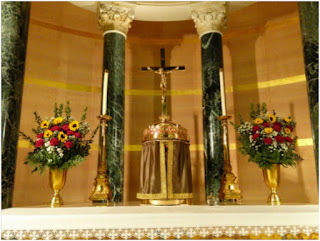The Fountain Of Mercy
In meditating with this stained
glass during Divine Mercy Sunday, the element that first catches my eye is the
abundant water, which is presented here as seven streams (seven being a number
for “fullness” in Sacred Scripture). This copious water is the “water of life”
(cf. Jer. 2:13), which we draw with joy from the
fountain of salvation (cf. Is. 12:3). This fountain is Jesus Christ himself, as it is indicated by the
cross and by the Greek letter that looks like a “P” at the very center of the
fountain (one of the earliest christograms).
One can also observe that the water is being portrayed as reaching ever-higher places, since the water
Christ gives us becomes “a spring of water welling up to eternal life” (cf. Jn.
4:14).
What about the red circles in the
background? Jesus Christ came “not by water alone, but by water and blood” (cf. 1
Jn. 5:6b). One may be led to think that this
represents the blood that is being pouring out from Christ’s side along with
water. As fitting as that interpretation would be during today’s celebration of
Divine Mercy Sunday, one would be hard-pressed to explain why there are three circles, or why the blood is
portrayed as circles rather than in liquid form. A simpler explanation is that
the three red circles represent the three Persons of the Blessed Trinity, since
red is sometimes used to portray the divine nature in religious art (compared
to the blueness of the water of Christ, portraying his human nature alongside
the divine nature).
The most interesting aspect of this
stained glass for me is that the fountain
itself can also be seen as a chalice. In other words, the water represents
not only the cleansing waters of baptism that must
cover us if we are to share in Christ’s death and resurrection, but also what (Who) we must drink in order to satisfy our eternal thirst for God.
Jesus, then, is not only the High Priest that will wash us from our sins, but
also the sacrificial victim whose body and blood we must eat and drink if we are to have
eternal life (cf. Jn. 6:54). This is why the refectory is the perfect place for this stained glass. “Our paschal
lamb, Christ, has been sacrificed. Therefore, let us celebrate the feast!” (cf. 1 Cor. 5:7-8a).
Written by Fernando Ricaud (Seminarian for the Diocese of Austin, TX)




Comments
Post a Comment